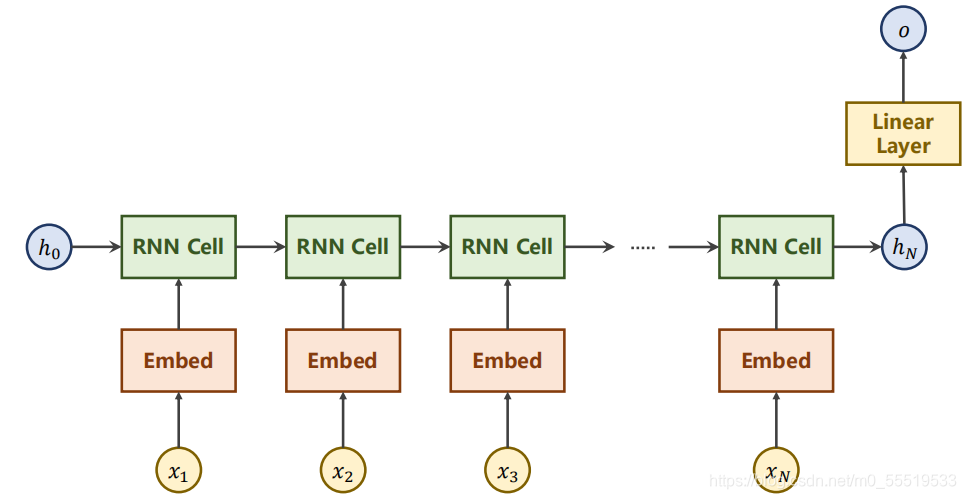第13讲 循环神经网络(高级篇)
数据集链接:https://pan.baidu.com/s/1bIKasCIDAaT-_EwB6hcAMQ
提取码:4fij
任务:使用RNN通过训练name数据集来预测name属于哪个country.
RNN,LSTM,GRU都是循环神经网络。
网络模型:


最后只需要一个Linear Layer来得出整个name序列的预测结果。
数据准备
Name序列处理步骤:
1.Name转成序列List,即Maclean→[‘M’, ‘a’, ‘c’, ‘l’, ‘e’, ‘a’, ‘n’]
2.用ASCⅡ码表示List中的元素,即[77 97 99 108 101 97 110],里面不是代表数值,而是one-hot向量,比如77是指共128维的向量,只有Idex77是1,其他都是0
3.Padding将一个batch_size的序列填充成长度相同,即[77 97 99 108 101 97 110 0 0 0]
4.将Padding后的矩阵转置
5.按照序列长度降序排列
同时要获得对应顺序的序列长度列表[10, 8, 7, 7, 7, 7,6, 6, 5]
Country的处理步骤:
给每个Country一个索引,构成字典{‘country’: idx},在name排序之后,也要按照相同的排序将name对应的Country标签排序。
就是说,在拿到一个name后,就能根据name在batch_size中的位置找到country,再进一步找到分类标签idx。
双向RNN
从
算一遍
,再从
算一遍
,将相应的
和
拼接起来,最终得到的hidden=[
,
]。
是否双向在代码中通过bidirectional = 1或2 体现。
torch.nn.GRU()
1.维度
input:(seqlen, batch_size, hidden_size)
output:(seqlen, batch_size, hidden_size * nDirections)
hidden:(nLayers * nDirections, batch_size, hidden_size)
2.参数设置
torch.nn.GRU(hidden_size, hidden_size, num_layers, bidirectional=_)
torch.nn.utils.rnn.pack_padded_sequence()
1.作用:提升GRU的运行效率
2.用法:经过embadding之后的维度(seqlen, baych_size, hidden_size)
随后通过rnn.pack_padded_sequence(embadding, seq_lengths)对非零的值进行打包
示例代码:
import torch
import gzip
import csv
from torch.utils.data import DataLoader
import numpy as np
from torch.nn.utils import rnn
from torch.utils.data import Dataset
import time
import matplotlib.pyplot as plt
import math
#参数初始化
Hidden_size = 100
Batch_size = 256
Num_layers = 2
Num_epoch = 10
Num_chars = 128
use_gpu = False
class NameDataset(Dataset):
'构造数据集'
def __init__(self, is_train_set=True):
super(NameDataset, self).__init__()
filename = 'E:/image-dataset/names_sets/names_train.csv.gz' if is_train_set else 'E:/image-dataset/names_sets/names_test.csv.gz'
with gzip.open(filename, 'rt') as f:
reader = csv.reader(f)
rows = list(reader) #rows=[(name,country),(name,country),...]
self.names = [row[0] for row in rows]
self.len = len(self.names)
self.countries = [row[1] for row in rows]
self.country_list = list(sorted(set(self.countries))) #经过去重、排序后得到country列表
self.country_dict = self.getCountryDict() #用此函数将list转成对应的dict,['country1':idx分类号,'country2':idx分类号,...]
self.country_num = len(self.country_list)
def __getitem__(self, index):
'为了数据集能提供索引访问,返回:索引对应的name字符串,索引对应的country的分类号'
return self.names[index], self.country_dict[self.countries[index]]
def __len__(self):
return self.len
def getCountryDict(self):
country_dict = dict()
for idx, country_name in enumerate(self.country_list, 0):
country_dict[country_name] = idx
return country_dict
def idx2country(self,index):
return self.country_list[index]
def getCountryNum(self):
return self.country_num
#数据准备
train_sets = NameDataset(is_train_set=True)
train_loader = DataLoader(train_sets, batch_size = Batch_size, shuffle=True)
test_sets = NameDataset(is_train_set=False)
test_loader = DataLoader(test_sets, batch_size=Batch_size, shuffle=False)
Num_country = train_sets.getCountryNum() #模型最终的分类类别数
def create_tensor(tensor):
if use_gpu:
device = torch.device("cuda:0")
tensor = tensor.to(device)
return tensor
def name2list(name):
"读取名字的每个字符 对应的 的ASC码值,将名字list变成由ASC表示的列表.输出元组:名字的ASC表示 和 名字长度"
arr = [ord(c) for c in name]
return arr, len(arr)
def make_tensors(names, countries):
sequences_and_lengths = [name2list(name) for name in names]
name_sequences = [sl[0] for sl in sequences_and_lengths]
seq_lengths = torch.LongTensor([sl[1] for sl in sequences_and_lengths])
countries = countries.long()
# make tensor of name, Batchsize*seqlen
seq_tensor = torch.zeros(len(name_sequences), seq_lengths.max()).long()
for idx, (seq, seq_len) in enumerate(zip(name_sequences, seq_lengths), 0):
seq_tensor[idx, :seq_len] = torch.LongTensor(seq) #idx对应的位置中,从0到name长度将name填进去
#按照name长度进行排序
seq_lengths, perm_idx = seq_lengths.sort(dim=0, descending=True)
seq_tensor = seq_tensor[perm_idx] #将这两个也按照相同的idx排序
countries = countries[perm_idx]
return create_tensor(seq_tensor),\
create_tensor(seq_lengths),\
create_tensor(countries)
class RNNClassifier(torch.nn.Module):
'构造RNN分类器模型'
def __init__(self, input_size, hidden_size, output_size, n_layers=1,bidirectional=True):
super(RNNClassifier, self).__init__()
self.hidden_size = hidden_size
self.n_layers = n_layers
self.directions = 2 if bidirectional else 1
self.embadding = torch.nn.Embedding(input_size, hidden_size)
self.gru = torch.nn.GRU(hidden_size, hidden_size, n_layers, bidirectional=bidirectional)
self.fc = torch.nn.Linear(hidden_size * self.directions, output_size)
def _init_hidden(self,batch_size):
hidden = torch.zeros(self.n_layers * self.directions, batch_size, self.hidden_size)
return create_tensor(hidden)
def forward(self,input, seq_lengths):
'input:所有序列,seq_lengths:每个序列的长度'
input = input.t() #将input做转置,由batch×seq_len到seq_len×batch
batch_size = input.size(1) #用它来构造最初的隐层H0
hidden = self._init_hidden(batch_size)
embadding = self.embadding(input) #shape:(seq_len,batchsize,hiddensize)
# 将序列按照长度降序打包
gru_input = rnn.pack_padded_sequence(embadding, seq_lengths)
output, hidden = self.gru(gru_input, hidden)
if self.directions==2:
hidden_cat = torch.cat([hidden[-1], hidden[-2]], dim=1)
else:
hidden_cat = hidden[-1]
fc_output = self.fc(hidden_cat)
return fc_output
def time_since(since):
s = time.time()-since
m = math.floor(s/60)
s -= m * 60
return '%dm %ds' % (m, s)
def trainModel():
total_loss = 0
for i, (names,countries) in enumerate(train_loader,1):
inputs, seq_lengths, targets = make_tensors(names,countries)
output = classifier(inputs, seq_lengths)
loss = criterion(output, targets)
optimizer.zero_grad()
loss.backward()
optimizer.step()
total_loss += loss.item()
if i % 10 == 0:
print(f'[{time_since(start)}] Epoch {epoch}', end='')
print(f'[{i * len(inputs)}/{len(train_sets)}]',end='')
print(f'loss={total_loss / (i * len(inputs))}')
return total_loss
def testModel():
correct = 0
total = len(test_sets)
print('evaluating trained model...')
with torch.no_grad():
for i, (names, countries) in enumerate(test_loader, 1):
inputs, seq_lengths, targets = make_tensors(names, countries)
output = classifier(inputs, seq_lengths)
pred = output.max(dim=1, keepdim=True)[1]
correct += pred.eq(targets.view_as(pred)).sum().item()
percent = '%.2f' % (100 * correct / total)
print(f'Test set:Accuracy {correct} / {total} {percent}%')
return correct / total
#参数初始化
if __name__=="__main__":
classifier = RNNClassifier(Num_chars, Hidden_size, Num_country, Num_layers)
if use_gpu:
device = torch.device('cuda:0')
classifier.to(device)
criterion = torch.nn.CrossEntropyLoss()
optimizer = torch.optim.Adam(classifier.parameters(), lr=0.001)
start = time.time()
print('Training for %d epochs...' % Num_epoch)
acc_list = []
for epoch in range(1,Num_epoch+1):
trainModel()
acc = testModel()
acc_list.append(acc)
epoch = np.arange(1, len(acc_list) + 1, 1)
acc_list = np.array(acc_list)
plt.plot(epoch, acc_list)
plt.xlabel('Epoch')
plt.ylabel('Accuracy')
plt.grid()
plt.show()
说明:m.sort(dim = _, descending = _),dim=0或1,0是按列排序,1是按行排序;descending=True是由大到小,false是由小到大。最后返回:1.排序后的序列;2.排序后对应的原来的idx。
































 被折叠的 条评论
为什么被折叠?
被折叠的 条评论
为什么被折叠?










